Dec 19, 2015 | commentary, policy, US Mint
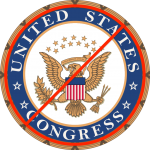 The day after announcing the end to mail order purchasing, the U.S. Mint issued a statement saying, “The United States Mint is currently analyzing a policy change to discontinue the distribution of mail order forms in 2016.”
The day after announcing the end to mail order purchasing, the U.S. Mint issued a statement saying, “The United States Mint is currently analyzing a policy change to discontinue the distribution of mail order forms in 2016.”
Product brochures that will be mailed in January will not contain a mail order form, probably because the production has been completed and would be too expensive to change at this time.
Word on the street says that a few people complained to their member of congress who then contacted the U.S. Mint. Although there are rumors as to the congress person that made contact with Treasury officials, there are no reports confirming the identity of the suspect.
Once again, congress proves that you cannot run the government like a business because in a business, the Board of Directors can demonstrate a modicum of common sense.
Nov 24, 2015 | coins, commemorative, commentary, legislative, policy, US Mint
While reviewing my notes I noticed that I had this draft in my queue. Although drafted in July, I think the topic is still relevant.
In 2009, I wrote a six-part series “Reforming America’s Currency” out of frustration with how behind the United States is in its currency production process (not economic policy) as compared with the rest of the world. After all, the U.S. Mint and the Bureau of Engraving and Printing are the largest money manufacturers in the world. In Part 4, I wrote that the “first reform in commemorative coinage would be that no commemorative would be struck for the sole purpose of raising money for any organization. Regardless of how worthy the organization may be, the association of the commemorative with fundraising taints the process.”
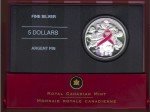
2006 Canada silver $5 Breast Cancer Commemorative Coin
In an astounding partisan move, some members of congress have chosen to display their political umbrage to try to derail a commemorative coin that has bipartisan support.
If you are not aware, the original version of H.R. 2722 would have given the proceeds to the Susan G. Komen for the Cure and the Breast Cancer Research Foundation. The argument was whether money raised by the commemorative should go to Komen. As a not-for-profit charitable corporation, Komen supports education and research to fight breast cancer. The organization, founded in 1983, has been one of the more successful organizations in education and providing research funds in the fight against breast cancer.
Komen is not without controversy. Most have been within the last 10 years when the organization has grown to such size and scope that some feel it may be more corporate driven than focused on its original mission. One of its controversies is its association with Planned Parenthood. Komen, who gives grants to organization for women cancer screenings, had been proving grants to Planned Parenthood earmarked for cancer screenings. Since Planned Parenthood has also had its share of controversies, social conservatives balked at the association.
More recently, Planned Parenthood has been accused of unethical practices regarding their medical-related practices. A video surfaced that claims someone at Planned Parenthood would be selling fetal tissue following abortions. It was a hidden camera video whose contents have not been verified. Although the video has some disturbing conversations, it is unknown whether this is an isolated incident or a policy followed by some.
Because of the politics surrounding the abortion issue, the policies of Planned Parenthood, and Komen’s support of Planned Parenthood’s cancer screening programs, Komen was open to attack by right wing demagogues looking to score political points rather by using the concept of guilt by association rather than rational thinking.
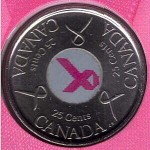
Canada’s non-controversial 2007 25-cent Breast Cancer circulating coin
Komen may have its controversies but the debate on this issue is beyond the pale. Their mission is for education and cancer research. Their mission should be as non-partisan as anything in this country. Cancer does not discriminate. Cancer will attack anyone at any time for any reason regardless of affiliation outside of being a sentient being.
To bring any other issue into the discussion, regardless of where you fall on the political spectrum, shows congress’s immaturity and that the basic function of raising money using commemorative coins should be discontinued immediately.
Some will be upset over my discussion of politics, but politics are part of the coin making process since the U.S. Mint cannot do much without permission. I also both sides of the issue, but for this debate, I do not care. When you have to go three-degrees of separation to dig up an issue in an unrelated political debate, it gets frustrating. It is yet another illustrations as to why I am against using commemorative coins to raise money for any cause regardless of how I feel about the cause—and I have personal reasons for being in favor of cancer research and education. This debate should have NEVER devolved into a discussion about abortion. The fact that it did stoop to those depths proves that congress needs to get out of the commemorative coin business. It will be one less area they can mess up.
Nov 5, 2015 | coins, commemorative, legislative, policy, US Mint
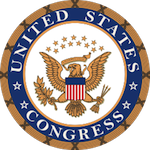 Those who follow politics has watched the machinations that the House of Representatives went through before picking Rep. Paul Ryan (R-WI) as the 54th Speaker of the House of Representatives. During that time, not much else happened outside of the requisite budget battles. But there was one bill introduced that may be of interest:
Those who follow politics has watched the machinations that the House of Representatives went through before picking Rep. Paul Ryan (R-WI) as the 54th Speaker of the House of Representatives. During that time, not much else happened outside of the requisite budget battles. But there was one bill introduced that may be of interest:
S. 2185: Breast Cancer Awareness Commemorative Coin Act
Sponsor: Sen. Heidi Heitkamp (D-ND)
• Introduced: October 20, 2015
• Referred to the Senate Banking, Housing, and Urban Affairs Committee
• Summary:
- 2018 Commemorative program
- 50,000 $5 “pink gold” coins with $35 surcharge
- 400,000 silver $1 coins with $10 surcharge
- 750,000 clad half-dollars with $5 surcharge
- Surcharge paid to Breast Cancer Research Foundation for the purpose of furthering breast cancer research
Track this bill at https://www.govtrack.us/congress/bills/114/s2185

iPhone 6S in Rose Gold
If you think that this bill looks very much like H.R. 2722, you are a very perceptive person. The only difference between this bill and H.R. 2722 is the specification to use “pink gold.” Pink gold is actually “rose gold,” which has a pinkish hue. For the record, Apple’s new iPhone 6S comes in rose gold that looks more pink that “rose.”
Speaking of budget bills, one of those bills, S. 2132, has been reported out of committee and waiting for a Senate vote. What is significant about the bill is that it outlines how much money the U.S. Mint can withdraw from the Public Enterprise Fund, the account where the seigniorage from all coin sales is deposited. The bill states:
United States Mint – United States Mint Public Enterprise Fund
Pursuant to section 5136 of title 31, United States Code, the United States Mint is provided funding through the United States Mint Public Enterprise Fund for costs associated with the production of circulating coins, numismatic coins, and protective services, including both operating expenses and capital investments: Provided, That the aggregate amount of new liabilities and obligations incurred during fiscal year 2016 under such section 5136 for circulating coinage and protective service capital investments of the United States Mint shall not exceed $20,000,000.
iPhone image courtesy of Apple.
Sep 6, 2015 | coins, commentary, legislative, policy
 Usually, I open the month with a report on the coin-related legislation from last month. In August, congress went on their summer vacation and did not work on any legislation. There are many who think that given the way congress has done little to nothing over the last few years, this may have been a good thing. When congress returns after Labor Day, there is work on their schedules. While I expect the same level of non-work as before their vacation, there are the issues that have a high probability of being worked on.
Usually, I open the month with a report on the coin-related legislation from last month. In August, congress went on their summer vacation and did not work on any legislation. There are many who think that given the way congress has done little to nothing over the last few years, this may have been a good thing. When congress returns after Labor Day, there is work on their schedules. While I expect the same level of non-work as before their vacation, there are the issues that have a high probability of being worked on.
H.R. 2722: Breast Cancer Awareness Commemorative Coin Act
Sponsor: Rep. Carolyn Maloney (D-NY)
• Introduced: June 10, 2015
• Passed the House: July 15, 2015
• Received by the Senate: July 16, 2015
• Referred to the Senate Banking, Housing, and Urban Affairs Committee
• Summary:
- 2018 Commemorative program
- 50,000 $5 gold coins with $35 surcharge
- 400,000 silver $1 coins with $10 surcharge
- 750,000 clad half-dollars with $5 surcharge
- Surcharge paid to Breast Cancer Research Foundation for the purpose of furthering breast cancer research
Track this bill at https://www.govtrack.us/congress/bills/114/hr2722
Aside that this would be a swan-song for an a long-serving representative that is retiring, even after the argument about who should receive the money the concept is popular in congress. It is likely to pass the Senate either as a formality or under a suspension of the rules with only a voice vote taken. If there are any votes against this bill, it will be from the senators who have said that they are against using commemorative coins as a fundraising mechanism (see H.R. 3097).
H.R. 1698: Bullion and Collectible Coin Production Efficiency and Cost Savings Act
Sponsor: Rep. Bill Huizenga (R-MI)
• Introduced: March 26, 2015
• Passed the House of Representatives on June 23, 2015 by voice vote
• Received in the Senate on June 24, 2015 and referred to the Committee on Banking, Housing, and Urban Affairs
Track this bill at https://www.govtrack.us/congress/bills/114/hr1698
Back in February, I wrote that congress was being lazy and that as members and their staffs were writing commemorative coin acts, they were copying from old legislation. While this makes it easy for them to deal with, the U.S. Mint has asked that this be changed to save money. Time and again, congress has been told that the U.S. Mint could save money if they standardized gold coins to 24-karat coins and silver to at least .999 fine quality. Aside from making the coins more attractive to more buyers including investors, the U.S. Mint does not have to pay more for someone to “dirty” the metals to create planchets that contain 90-percent of the metals.
This bill should be easy for congress to deal with. It does not spend any taxpayer money and has the ability to add money to the General Treasury. Since H.R. 1698 has passed the House under suspension of the rule (voice vote), it should not have problems in the Senate.
An issue that is likely to be raised that has been a part of a lot of bills is the elimination of the paper $1 note. This came up again when Sen. John McCain (R-AZ) was unequivocal about seeing the $1 note retired in favor of a coin. McCain has supported this type of legislation in the past but his going out of the way to emphasize this as an issue makes it interesting. As one of the oldest members of congress, his opinion is a minority of those of his generation. Surveys have shown there is a clear generational divide as to who supports this measure. When, the Baby Boomers (those born before 1964) and those older are overwhelmingly not in favor of eliminating the the paper note. The GenXers, those born 1965-1980, are almost evenly divided while the Millenials, those born since 1980, do not care because they are mostly tied to their credit and debit cards.
For the longest time, the Massachusetts delegation have held these types of bills back. This is because the Dalton, Massachusetts based Crane & Co., the maker of currency paper, has been the exclusive currency paper supplier to the Bureau of Engraving and Printing since 1879. Although Elizabeth Warren (D-MA) has become a more powerful figure in the Senate, she does not have the gravitas of a previous holder of that seat, the late Sen. Ted Kennedy (D). Additionally, with John Kerry now the Secretary of State and other changes in the House, like the retiring of Barney Frank (D-MA), the Massachusetts delegation does not have the same power as it once had. The only power the Senators have would be to filibuster any measure that would eliminate the $1 note. Whether they will do this remains to be seen.
Aug 7, 2015 | Britain, coins, commentary, policy, US Mint
As part of my perusal of the Internet looking for numismatic-related stories, I stumbled upon an article at the website for The Guardian about the Royal Mint’s operating income and profits. The story touted how the Royal Mint, whose history can be traced back over 1,000 years, increased over 70-percent from the previous year.
Using The Guardian’s reporting, I wondered how the Royal Mint would stack up against the U.S. Mint. Even though the story was published on July 23, 2015 and the U.S. Mint’s data is for Fiscal Year 2014 that ended on September 30, 2014, I am using the conversion rate of at the time I write this of £1 is equivalent to $1.55.

Revenues
The Guardian reported that the Royal Mint earned £260 million in revenues. This is equivalent to just over $404 million. In contrast, the U.S. Mint boasted revenues of over $3.1 billion or a bit over £1.995 billion. Yes, that is BILLION with a “B.” While the Royal Mint’s revenue was depicted as being the most in the institution’s history, the U.S. Mint’s record revenues came in 2011 when it earned $4.970 billion.
Profit
What good is making money if there are no profits. The Royal Mint reported a record profit of £11.5 million or just over $17.7 million. The U.S. Mint did slightly better by reporting a seigniorage of $367.9 million or more than £236.756 million. Even if you take it as a percentage, the Royal Mint’s profit margin is 4.38-percent while the U.S. Mint has a profit margin of 11.86-percent.
Benefit to their respective governments
The Royal Mint is wholly owned by the British Treasury. They pay a £4 million ($6.218 million) dividend to the British government. By law, the seigniorage earned by the U.S. Mint is deposited in their Public Enterprise Fund. The Treasury Department requests a budget for the U.S. Mint which is then approved by congress. The funds are withdrawn from the Public Enterprise Fund. Allowing for overages, the Secretary of the Treasury then transfers the rest of the money to the U.S. General Funds where it is used to pay whatever the government needs. In 2014, $272 million (£174.971 million) was deposited into the General Funds, more than 43-times the dividend that the Royal Mint pays the British government.
The U.S. Mint is the most profitable agency in the United States government. No other mint in the world can match the U.S. Mint’s production, income, and profit. The U.S. Mint even out performs private industry. The average profit margin in the United States is 5.1-percent.
The next time someone complains that it costs too much to make a specific coin, remind them that the U.S. Mint provides more benefit to the government than the loss of a little profit on a few coins.
Royal Mint logo courtesy of the Royal Mint.
U.S. Mint seal courtesy of the United States Department of the Treasury.
Aug 5, 2015 | coins, commemorative, gold, legislative, news, platinum, policy, US Mint
 The term Dog Days goes back to ancient Roman times when calendars were measured by the stars. While trying to measure time, the hottest part of the summer would coincide with the brightest star, Sirius, being dominant in the sky. Sirius is part of the constellation Canis Major (big dog).
The term Dog Days goes back to ancient Roman times when calendars were measured by the stars. While trying to measure time, the hottest part of the summer would coincide with the brightest star, Sirius, being dominant in the sky. Sirius is part of the constellation Canis Major (big dog).
During the period from about 20 days prior to the height of Sirius to 20 days following, Canis Major would only appear with the sunrise and sunset. Because ancient Romans thought Sirius contributed to the heat and humidity, this period would be called the Dog Days.
Today’s society has attached many meanings to the Dog Days of Summer. In baseball, it is the jockeying for position to get ready for the pennant races. Football begins training camps, politicians warm up to run for office (sometimes a year early), and the temperatures are rising with the east getting too wet and the west not getting wet enough.
These contrasts illustrate a congress that sometimes looks like they are really trying to do something and then really trying to put the “fun” in dysfunctional!
In July, it looks like congress really tried to do some work. Here are the coin-related legislative actions from our from our representatives on Capitol Hill:
It’s the law!
H.R. 893: Boys Town Centennial Commemorative Coin Act
Sponsor: Rep. Jeff Fortenberry (R-NE)
• Introduced: February 11, 2015
• Signed by the President: July 6, 2015
• Public Law 114-30
• Summary:
- 2017 Commemorative program
- 50,000 $5 gold coins with $35 surcharge
- 350,000 silver $1 coins with $10 surcharge
- 300,000 clad half-dollars with $5 surcharge
- Surcharge paid to Boys Town
Read the details of this law at https://www.govtrack.us/congress/bills/114/hr893
Passed the House
H.R. 2722: Breast Cancer Awareness Commemorative Coin Act
Sponsor: Rep. Carolyn Maloney (D-NY)
• Introduced: June 10, 2015
• Passed the House: July 15, 2015
• Received by the Senate: July 16, 2015
• Referred to the Senate Banking, Housing, and Urban Affairs Committee
• Summary:
- 2018 Commemorative program
- 50,000 $5 gold coins with $35 surcharge
- 400,000 silver $1 coins with $10 surcharge
- 750,000 clad half-dollars with $5 surcharge
- Surcharge paid to Breast Cancer Research Foundation for the purpose of furthering breast cancer research
Track this bill at https://www.govtrack.us/congress/bills/114/hr2722
Commemorative Coin Legislation Introduced
H.R. 2980: Mayflower Commemorative Coin Act
Sponsor: Rep. Bill Foster (D-IL)
• Introduced: July 8, 2015
• Referred to the House Committee on Financial Services
• Summary:
- 2020 Commemorative program
- 50,000 $5 gold coins with $35 surcharge
- 100,000 silver $1 coins with $10 surcharge
- Surcharge paid to General Society of Mayflower Descendants for educational purposes.
Track this bill at https://www.govtrack.us/congress/bills/114/hr2980
S. 1715: Mayflower Commemorative Coin Act
Sponsor: Sen. John Hoeven (R-ND)
• Introduced: July 8, 2015
• Referred to the Senate Banking, Housing, and Urban Affairs Committee
• Summary: see H.R. 2980, above
Track this bill at https://www.govtrack.us/congress/bills/114/s1715
H.R. 2978: Thirteenth Amendment Commemorative Coin Act
Sponsor: Rep. Danny Davis (D-IL)
• Introduced: Jul 8, 2015
• Referred to the House Committee on Financial Services
• Summary:
- 2015 Commemorative program
- 250,000 $50 bi-metallic (gold & platinum) with $10 surcharge
- 250,000 $20 gold coins with $10 surcharge
- 500,000 silver $1 coins with $10 surcharge
- Surcharge paid to Smithsonian National Museum of African American History and Culture.
Track this bill at https://www.govtrack.us/congress/bills/114/hr2978
Other coin-related legislation
H.R. 3097: Commemorative Coins Reform Act of 2015
Sponsor: Rep. Justin Amash (R-MI)
• Introduced: Jul 16, 2015
• Referred to the House Committee on Financial Services
• Summary: If passed, this bill will prohibit payment of surcharges from commemorative coins to organizations outside of the federal government.
Track this bill at https://www.govtrack.us/congress/bills/114/hr3097
H.R. 3300: To reduce waste and implement cost savings and revenue enhancement for the Federal Government.
Sponsor: Rep. Robert Pittenger (R-NC)
• Introduced: Jul 29, 2015
• Referred to many committees including the House Committee on Financial Services
Track this bill at https://www.govtrack.us/congress/bills/114/hr3300
Jul 11, 2015 | news, policy, US Mint
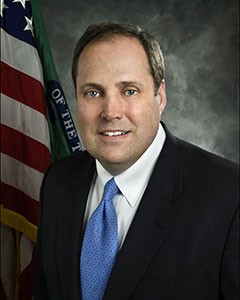
Rhett Jeppson
In January, Treasurer of the United States Rosie Rios Principal Deputy Director announce the appointment of Jeppson as the Principal Deputy Director. In that role, Jeppson is responsible for the day-to-day operation of the bureau.
This is President Obama’s second attempt at nominating a director for the U.S. Mint. In September 2012, Obama tried to nominate Bibiana Boerio to the position. The former Chief Financial Officer of Ford Motor Credit and Managing Director of Jaguar Cars Ltd, then a subsidiary of Ford, did not receive consideration from the Senate before the 112th congress adjourned for the last time.
The U.S. Mint has not had a permanent director in 54 months, since Edmund Moy resigned in January 2011. Since Moy’s departure, Deputy Director Richard Peterson has been capably running the world’s largest coin manufacturing agency. Peterson returned to the position of Deputy Director for Manufacturing and Quality on Jeppson’s appointment.
Since the Director of the U.S. Mint is an appointed position, the U.S. Senate has the power of “Advice and Consent” on the nominations to head departments. Until this do-less-than-nothing congress gets around to doing their job, Jeppson will continue to manage the U.S. Mint as a federal executive employee but without the Director’s title.
Jeppson’s biography in the President’s announcement was as follows:
Matthew Rhett Jeppson, Nominee for Director of the Mint, Department of the Treasury
Matthew Rhett Jeppson is the Principal Deputy Director of the Mint, a position he has held since January 2015. Mr. Jeppson was Associate Administrator in the Office of Veterans Business Development at the Small Business Administration (SBA) from 2012 to 2015 and also served as the Acting Chief Operating Officer of SBA from 2014 to 2015. From 2010 to 2012, he was Lead Crisis Response Planner at U.S. European Command. Mr. Jeppson served as Deputy Director of Operations for U.S. Forces Afghanistan from 2009 to 2010. From 2004 to 2008, he was Chief of Joint National Training Capability and European Engagements Lead at the United States Special Operations Command and served as Counter-Terrorism Planner and Chief of Current Operations for Marine Forces Europe from 2001 to 2003. Mr. Jeppson was Director of State Purchasing and Special Assistant to the Secretary at the Department of Business and Professional Regulation of the State of Florida from 1999 to 2003, and he served as Operations and Exercise Officer at Special Operations Command Central from 1995 to 1999. He was Vice President of E. Mark Jeppson, Inc. from 1992 to 1994. He also served as Principal Battalion Staff Officer, 81mm Mortar Platoon Commander, Rifle Company Executive Officer, and Rifle Platoon Commander in the 1st Marine Division from 1989 to 1991. Mr. Jeppson received a B.A. from the University of Florida.
Jeppson image courtesy of the U.S. Mint.
Jul 1, 2015 | coins, commemorative, commentary, legislative, policy
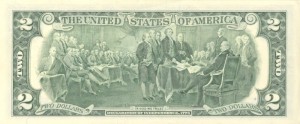
Reverse of the $2 Federal Reserve Note features an engraved modified reproduction of the painting The Declaration of Independence by John Trumbull.
On June 11, rather than let Jefferson continue his draft, the Continental Congress elected the Committee of Five to write the full document. John Adams, whose role in the Continental Congress would be that of the Majority Leader today, was a member of the Committee of Five but insisted that most of the writing be done by Jefferson. The other members of the Committee of Five were Ben Franklin, Roger Sherman, and Robert Livingston.
The committee presented the document to the Continental Congress on June 25. For the next seven days, the document went through the first ever mark-up session where members applied their edits to the document. Debate began on July 1 and by July 2 everyone who wanted to speak has their say before the vote. With each delegation allowed one vote, the final tally was 9 in favor of independence, 2 against (Pennsylvania and South Carolina), and one abstention (New York, their delegation did not have their legislature’s authority to cast a vote).
But if you thought that this was the end of the debate, you failed to remember that this was the beginnings of congress! The vote was conditional on Jefferson revising the document before it was adopted. The rewrite was completed and presented the final copy to the Continental Congress on July 4, 1776 where it passed with the same vote. Adams felt that July 2 should be considered Independence Day. A combination of the day that the text was adopted and what we would consider in today’s environment to be a clerical error, the Declaration of Independence was signed (on August 2, 1776) saying that independence was declared on July 4, 1776.
The moral of this story is that no matter how ridiculous the bill or idea, it is not law until the final version of the bill is approved and signed.
Congress had a busy June with regard to coin-related legislation. The bills that saw action were as follows:
H.R. 2722: Breast Cancer Awareness Commemorative Coin Act
Sponsor: Rep. Carolyn Maloney (D-NY)
• Introduced: June 10, 2015
• Referred to the House Committees on Financial Services and Budget
Track this bill at https://www.govtrack.us/congress/bills/114/hr2722
H.R. 2726: Apollo 11 50th Anniversary Commemorative Coin Act
Sponsor: Rep. Bill Posey (R-FL)
• Introduced: June 10, 2015
• Referred to the House Committee on Financial Services
Track this bill at https://www.govtrack.us/congress/bills/114/hr2726
H.R. 1698: Bullion and Collectible Coin Production Efficiency and Cost Savings Act
Sponsor: Rep. Bill Huizenga (R-MI)
• Introduced: March 26, 2015
• Passed the House of Representatives on June 23, 2015 by voice vote
• Received in the Senate on June 24, 2015 and referred to the Committee on Banking, Housing, and Urban Affairs
Track this bill at https://www.govtrack.us/congress/bills/114/hr1698
H.R. 893: Boys Town Centennial Commemorative Coin Act
Sponsor: Rep. Jeff Fortenberry (R-NE)
• Introduced: February 11, 2015
• Passed the House of Representatives on June 23, 2015 by voice vote
• Passed the Senate on June 25, 2015 by unanimous consent
• Presented to the President on June 26, 2015
Track this bill at https://www.govtrack.us/congress/bills/114/hr893
H.R. 2906: To require the Secretary of the Treasury to mint coins in recognition of the 50th anniversary of the Texas Western College National Collegiate Athletic Association men’s basketball championship.
Sponsor: Rep. Beto O’Rourke (D-TX)
• Introduced: June 25, 2015
• Referred to the House Committee on Financial Services
Track this bill at https://www.govtrack.us/congress/bills/114/hr2906
May 6, 2015 | BEP, coins, commemorative, currency, Federal Reserve, legislative, policy, US Mint
For those of us who are political junkies, April was a relatively quiet month. At least there was something to watch that was more related to the hobby than the usual partisan bickering. Here are the coin and currency-related legislation moving through congress:
S. 925: Women on the Twenty Act
Sponsor: Sen Jeanne Shaheen (D-NH)
• A bill to require the Secretary of the Treasury to convene a panel of citizens to make a recommendation to the Secretary regarding the likeness of a woman on the twenty dollar bill.
• Introduced: April 14, 2015
• Referred to the Senate Banking, Housing, and Urban Affairs Committee
Track this bill at https://www.govtrack.us/congress/bills/114/s925
S. 95: A bill to terminate the $1 presidential coin program
Sponsor: Sen. David Vitter (R-LA)
• Introduced: January 7, 2015
• Discharged from Senate Committee on Homeland Security and Governmental Affairs by Unanimous Consent on April 14, 2015
• Referred to the Senate Committee on Banking, Housing, and Urban Affairs on April 14, 2015
Track this bill at https://www.govtrack.us/congress/bills/114/s95
S. 985: United States Coast Guard Commemorative Coin Act
Sponsor: Sen. Christopher Murphy (D-CT)
• To require the Secretary of the Treasury to mint coins in commemoration of the United States Coast Guard.
• Introduced: April 16, 2015
• Referred to the Senate Banking, Housing, and Urban Affairs Committee
Track this bill at https://www.govtrack.us/congress/bills/114/s985
Apr 26, 2015 | coins, currency, legislative, policy
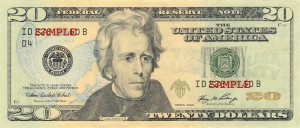 A few weeks after the Women on 20s group began their campaign, they gained the attention of congress to have two bills submitted to require the change be made.
A few weeks after the Women on 20s group began their campaign, they gained the attention of congress to have two bills submitted to require the change be made.
First up is Sen. Jeanne Shaheen (D-NH) who introduced Women on the Twenty Act (S. 925) on April 14, 2015 and referred to the Committee on Banking, Housing, and Urban Affairs, the bill is eight co-sponsor. All eight co-sponsors are Democrats and six are women.
Simply, the bill seeks to add a new paragraph to the Federal Reserve Act (12 U.S.C. § 418) to say:
The Secretary of the Treasury shall convene a panel of private citizens of the United States to advise and make recommendations to the Secretary regarding the likeness of a woman to appear on the face of $20 Federal reserve notes. In carrying out the requirements of the preceding sentence, each of the Secretary and the panel shall consider and weigh input provided by the American people.
While you read that paragraph, you have to understand that there is a little Washington-speak in the proposed law. All it says is that the Secretary is required to appoint a panel of private citizens, not government employees or appointees, to make a recommendation. It does not say that the Secretary is required take the committee’s recommendation nor does it it say that the Secretary is to do anything with the recommendation.
Essentially, unless the wording is changed, there is nothing in the above statement to require a woman appear on the $20 Federal Reserve Note. “Thank you for your recommendation,” a Secretary of the Treasury can say, “and have a nice day.”
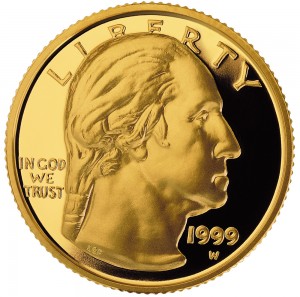
1999-W George Washington Commemorative using the design by Laura Gardin Frazer
Adding to the fray is a bill introduced by Louis Gutierrez (D-IL) whose title currently appears similar to that of Sen. Shaheen’s bill. Gutierrez’s bill (H.R. 1910) has no co-sponsors and was assigned to the House Financial Services Committee. As this is being written, the bill has not been published by the Government Printing Office making it difficult to compare this with S. 925.
Considering my last post about this topic, it will be interesting to see how this turns out. If I was to guess, one of the bills will be passed at the end of a session either by unanimous consent or an overwhelming vote in favor. A design will be produced but not in time to celebrate the 100th anniversary of suffrage. The wheels of politics and bureaucracy moves too slow and the engravers need time to engrave the plates.
Currency image courtesy of Wikimedia Commons.
Coin image courtesy of the U.S. Mint.
 The day after announcing the end to mail order purchasing, the U.S. Mint issued a statement saying, “The United States Mint is currently analyzing a policy change to discontinue the distribution of mail order forms in 2016.”
The day after announcing the end to mail order purchasing, the U.S. Mint issued a statement saying, “The United States Mint is currently analyzing a policy change to discontinue the distribution of mail order forms in 2016.”

 Those who follow politics has watched the machinations that the
Those who follow politics has watched the machinations that the 

 The term Dog Days goes back to ancient Roman times when calendars were measured by the stars. While trying to measure time, the hottest part of the summer would coincide with the brightest star, Sirius, being dominant in the sky. Sirius is part of the constellation Canis Major (big dog).
The term Dog Days goes back to ancient Roman times when calendars were measured by the stars. While trying to measure time, the hottest part of the summer would coincide with the brightest star, Sirius, being dominant in the sky. Sirius is part of the constellation Canis Major (big dog).



